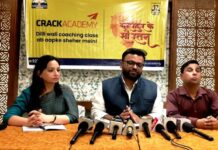Balancing the need for regulation to keep out obnoxious online content that promotes violence and vulgarity with the need to preserve our core constitutional values and freedom of expression is at the core of the new rules which have been formulated by the union government to address concerns regarding the new media.
The policy has tried to create the much-needed level-playing field between online news platforms and print media on the one hand and online and television news media on the other and to bring the online news portals within the ambit of the Code of Ethics that govern the print media like the norms of journalistic conduct drawn up by the Press Council Act, the Cable Television Networks (Regulation) Rules, 1994. This was long overdue because of the recklessness and irresponsibility that is on display in some of these platforms.
Similarly, while the cinema industry has a film certification agency with oversight responsibilities, OTT platforms have none. However, in order to ensure artistic freedom, the government has proposed self-regulation and said the OTT entities should get together, evolve a code and come up with content classification, so that a mechanism is evolved to preclude non-adults from viewing adult content. They must get down to do it. The grievance redressal mechanism thought of is three-tier, with the publishers and self-regulating bodies being the first two. The third tier is the central government oversight committee. The policy proposed requires publishers to appoint grievance redressal officers and ensure time-bound acknowledgement and disposal of grievances. Then, there can be a self-regulating body headed by a retired judge.
Online platforms are wary of rules that seek verification of accounts, access control etc, but these issues need to be resolved within the framework of India’s laws. For example, while mainstream media is conscious of provisions in the Indian Penal Code (IPC) dealing with promotion of violence, enmity among communities, defamation etc, content on online platforms seem to be totally oblivious of all this.
The vulgar comments posted on social media about women professionals in media or in other fields and the inability of the Indian State to deal with such behaviour makes one wonder whether the IPC is inapplicable in cyber space.
The Indian digital and OTT players can draw lessons from the concerted action taken by the digital companies in Australia which have come together and drawn up a code to deal with fake news and disinformation. It is called the Australian Code of Practice on Disinformation and Misinformation and it was released only recently by the Digital Industry Group.
Australian Communications and Media Authority (ACMA) has welcomed the initiative and said more than two-thirds of Australians were concerned about “what is real or fake on the internet”. In response, ACMA says the digital platforms agreed to self-regulatory code “to provide safeguards against serious harms arising from the spread of dis- and misinformation”. Some of the actions promised by the digital platforms include disabling of accounts and removal of content.
In the UK, the government is all set to bring in a law to make online companies responsible for harmful content and also to punish companies which fail to remove such content. The aim of the proposed “Online Safety Bill” is to protect internet users and deal firmly with platforms that promote violence, terrorist material, child-abuse, cyber bullying etc. The Digital Secretary, Mr.Oliver Dowden was quoted as saying “I’m unabashedly pro-tech but that can’t mean a tech free for all”. This in a sense sums up the current mood in this issue across democracies.
In the U.K, self-regulation governs the print media and private television and radio are regulated by the Independent Television Commission and the Radio Authority as provided by a statute.
As regards the two ministers who announced the government’s guidelines – Mr.Ravi Shankar Prasad and Mr.Prakash Javadekar – it should not be forgotten that both of them are the heroes of what is called the “Second Freedom Struggle” when they fought against the dreaded Emergency imposed by Prime Minister Indira Gandhi in the mid-1970s and suffered incarceration for about a year and a half, so that the people got back their constitution and democracy.
Obviously, their commitment to basic democratic values has and will continue to influence their policy formulations vis-à-vis media regulation.
Finally, a word about the framework within which companies should operate in India. As the union minister for Information Technology Mr.Ravi Shankar Prasad said, they must function with the laws of the land. This is non-negotiable.
In recent times, Twitter has tried to define freedom of expression and even claimed that it seeks to protect the freedom of expression of Indians. “Freedom of Expression” is embedded in our chapter on fundamental rights in our constitution and it is circumscribed by what are called “reasonable restrictions”. These are in place because India is a vibrant democracy and the most diverse society in the world with many social, political and economic complexities. That is why India’s founding fathers have, with great intuition and foresight introduced a caveat vis-à-vis freedom of expression, so that constitutional rights promote internal peace and harmony. What these freedoms are and what these restrictions are have been defined by our Supreme Court in innumerable cases and the law as laid down by India’s apex court is the law of the land. We do not want some private international companies to assume the role of some supra courts and put their own spin on our Constitution.














